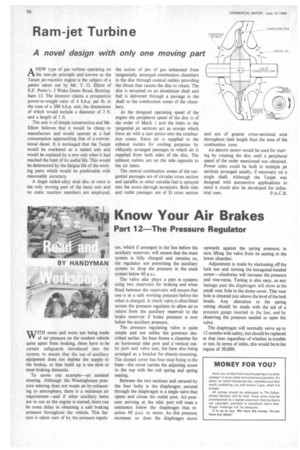Ram-jet Turbine
Page 52

If you've noticed an error in this article please click here to report it so we can fix it.
A novel design with only one moving part
A NEW type of gas turbine operating on the ram-jet principle and known as the Tanjet jet-reaction engine is the subject of a patent taken out by Mr. T. G. Elliott of E.F. Proto's, 3 Wake Green Road, Birmingham 13. The inventor claims a prospective power-to-weight ratio of 4 b.h.p. per lb. in the case of a 200 b.h.p. unit, the dimensions of which would include a diameter of 2 ft. and a length of 1 ft.
The unit is of simple construction and Mr. Elliott believes that it would be cheap to manufacture and would operate at a fuel consumption approaching that of a conventional diesel. It is envisaged that the Tanjet would be marketed as a sealed unit and would be replaced by a new unit when it had reached the limit of its useful life. This would be determined by the fatigue life of the working parts which would be predictable with reasonable accuracy.
A single nickel-alloy steel disc or rotor is the only moving part of the basic unit and no static reaction members are employed. the action of jets of gas exhausted from tangentially arranged combustion chambers in the disc through conical outlets providing the thrust that causCs the disc to rotate. The disc is mounted on an aluminium shaft and fuel is delivered through a passage in the shaft to the combustion zones of the chambers.
At the designed operating speed of the engine the peripheral speed of the disc is of the order of Mach I and the inlets to the tangential jet sections act as scoops which force air with a ram action into the combustion zones. Extra air is supplied to the exhaust outlets for cooling purposes by obliquely arranged passages to which air is supplied from both sides of the disc. The exhaust outlets are on the side opposite to the air inlets.
The central combustion zones of the tangential passages are of circular cross section and paraffin or other suitable fuel is sprayed into the zones through atomizers. Both inlet and outlet passages are of D cross section and, are of greater cross-sectional area throughout their length than the area of the combustion zone.
An electric motor would be used for starting by rotating the disc until a peripheral speed of the order mentioned was obtained. Power units could be built in multiple jet sections arranged axially, if necessary on a single shaft. Although the Tanjet was designed with automotive applications in mind it could also be developed for indus trial uses. P.A.C.B.




























































































































